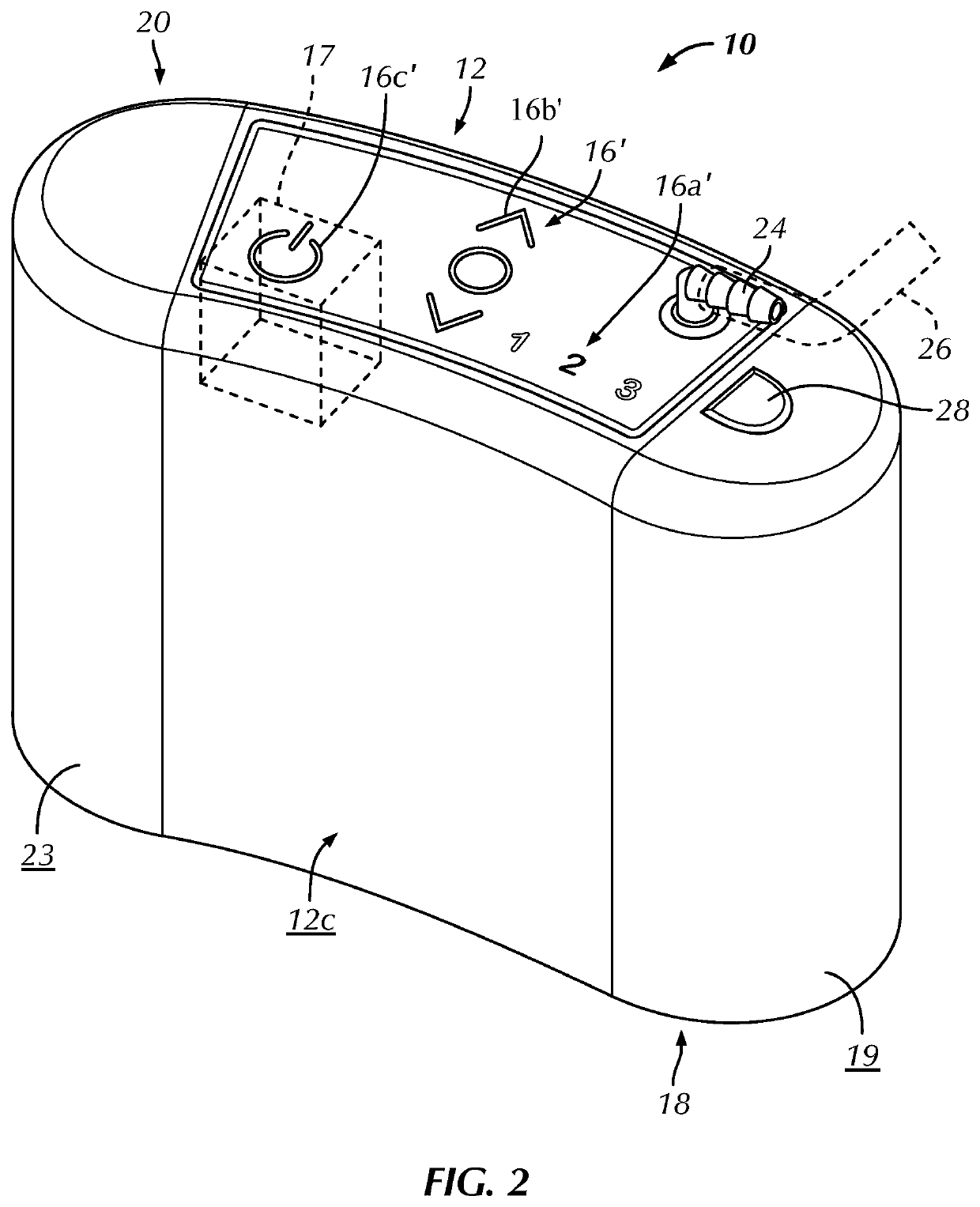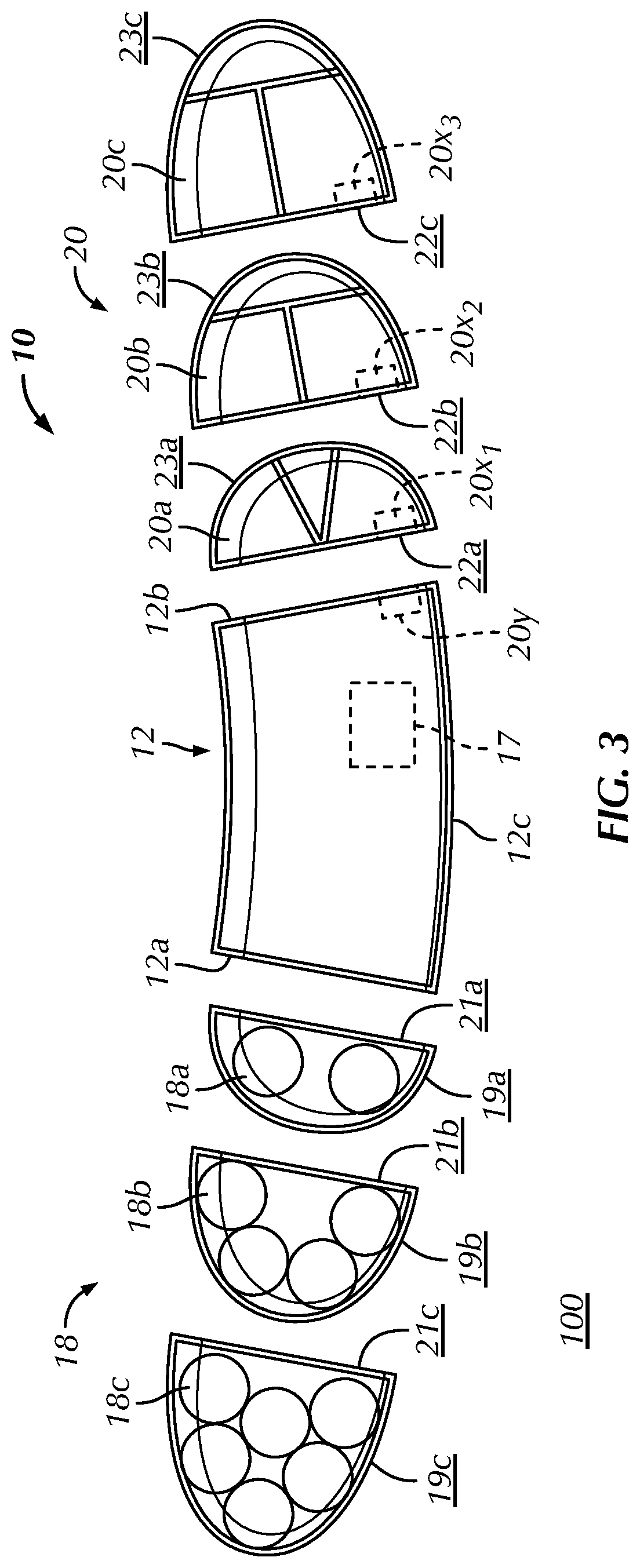Configurable oxygen concentrator and related method
a technology of oxygen concentrator and oxygen concentrator, which is applied in the direction of respirator, drug composition, separation process, etc., can solve the problems of increasing the risk of hypoxia, increasing the difficulty of transport for users, and prior art adsorbent modules or beds often rendered ineffective for nitrogen/oxygen separation
- Summary
- Abstract
- Description
- Claims
- Application Information
AI Technical Summary
Benefits of technology
Problems solved by technology
Method used
Image
Examples
example configuration 1
[0070]The first preferred configurable oxygen concentrator 10 has the electro-mechanical assembly 12 containing the compressor 14, valves and an associated manifold, electronic circuit boards, a cooling fan, and the user interface 16, including the display 16a, the selector dial 16b that permits selection of different concentrated oxygen flowrate within the specification of the concentrator 10 and the power button 16c. The electro-mechanical assembly 12 is preferably unchanged regardless of which of the batteries 18 or sieve modules 20 is attached to the electro-mechanical assembly 12. The electro-mechanical assembly 12 is roughly rectangular in cross-section and preferably has the interface 16, such as user controls and indicators on a top surface. The sieve or adsorbent modules 20 and batteries 18 are releasably connected to the opposite sides or first and second faces 12a, 12b of the electro-mechanical assembly 12. The batteries 18 preferentially house four (4), eight (8), twelve...
example configuration 2
[0071]The patient described in example 1 has now progressed to the second stage of the breathing disease and their physician recommends an increased oxygen flow of three liters per minute (3 LPM) equivalent. The physician may write a prescription for this increased flow and the DME would have supplied a completely different concentrator to the patient in the prior art method, because the patient's relatively low flow concentrator would not be capable of providing this increased flow and the DME would have to receive and replace the old concentrator with a generally larger capacity concentrator that is able to provide the increased flow rate. This procedure entailed retrieving the original concentrator provided to the patient and then delivering the new concentrator with new operating instructions and training, if necessary. This is a time-consuming and expensive procedure for the DME and the patient and requires the patient to wait for the increased flow rate concentrator while the ...
example configuration 3
[0073]The patient described in examples 1 and 2 has now progressed to the next stage of the breathing disease and requires the maximum flow that can normally be provided by a portable oxygen concentrator. This flow is typically, but not limited to, about four to five liters per minute (4-5 LPM) equivalent. So now an oxygen concentrator that can produce about one thousand milliliters per minute (1000 ml / m) is prescribed and a new concentrator must be supplied after the physician provides a prescription when the patient was confronted with this situation when using the prior art systems. The design of the preferred configurable oxygen concentrator 10 provides the third, larger flow rate sieve module or adsorbent container 22c that can accommodate this flow rate and is connectable to the electro-mechanical assembly 12. Again, the DME preferably sends the new sieve module, such as the third adsorbent container 20c, to the patient and the patient installs the third adsorbent module 20c j...
PUM
| Property | Measurement | Unit |
|---|---|---|
| weight | aaaaa | aaaaa |
| flow rates | aaaaa | aaaaa |
| flow rates | aaaaa | aaaaa |
Abstract
Description
Claims
Application Information
 Login to View More
Login to View More - R&D
- Intellectual Property
- Life Sciences
- Materials
- Tech Scout
- Unparalleled Data Quality
- Higher Quality Content
- 60% Fewer Hallucinations
Browse by: Latest US Patents, China's latest patents, Technical Efficacy Thesaurus, Application Domain, Technology Topic, Popular Technical Reports.
© 2025 PatSnap. All rights reserved.Legal|Privacy policy|Modern Slavery Act Transparency Statement|Sitemap|About US| Contact US: help@patsnap.com



